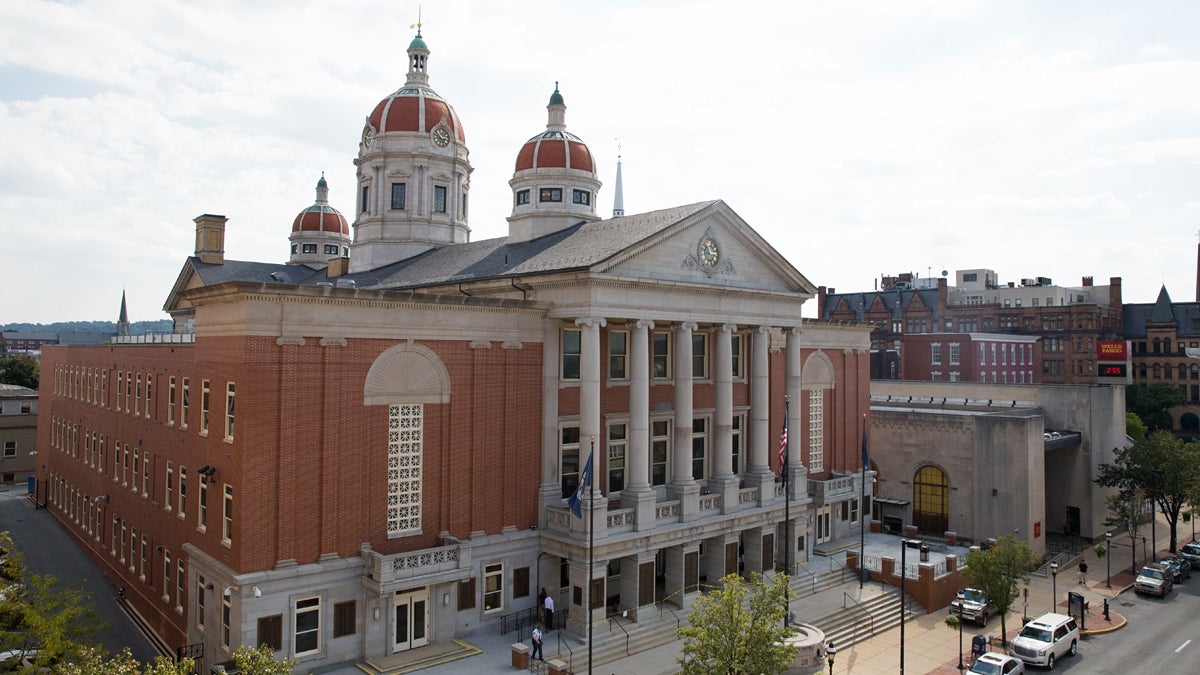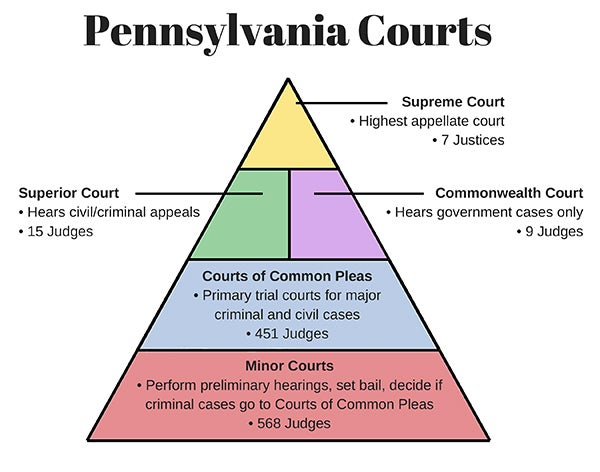Explainer: How does Pa.’s court system work?

The York County Courthouse with three domes is one of the iconic structures of the city. It was built in 1898 and has gone through multiple restoration projects and additions. (Lindsay Lazarski/WHYY)
What’s the difference between the Supreme Court, Superior Court, Commonwealth Court, Municipal Courts, and Magisterial District Courts?
Pennsylvania courts go almost as far back as the Commonwealth’s European history itself. William Penn established courts throughout the state in the 1600s. Back then, there was no Supreme Court and all final appeals had to go to England. The Pennsylvania Supreme Court was established in 1722, but the organization and jurisdiction of the system continued to evolve over the next two and a half centuries.

Today, Pennsylvania’s judicial system consists of various courts arranged in a pyramid-like hierarchy. At the top is the state Supreme Court, below it two intermediate appellate courts, then the Courts of Common Pleas, and at the very bottom the minor courts, which include Magisterial District Courts, the Philadelphia Municipal Court, and the Pittsburgh Municipal Court. A closer look at each level of the unified judicial system is below.
Minor Courts
There are three minor courts.
Magisterial District Courts evolved from justice of the peace posts, which primarily handled local matters and minor issues. Today, these courts hold much the same role; they process preliminary hearings and arraignments, function as small claims courts, set bail (except in murder cases), and decide whether to send criminal cases to a higher court. There are 526 Magisterial District Court Judges scattered in municipalities throughout the state. The judges are elected for six-year terms and they do not have to have a law degree to hold a judge’s seat—most do not.
The Commonwealth’s two largest cities have separate courts—the Philadelphia Municipal Court and the Pittsburgh Municipal Court. They basically have the same responsibilities as the district courts, with some minor differences. For example, the Philadelphia Municipal Court has 29 judges, with 27 in the general division and two in the traffic division. General Division judges need a law degree, but Traffic Division judges do not.
The Pittsburgh Municipal Court is staffed by 13 Magisterial District judges from Allegheny County (they’re included in the total number of magisterial district judges, above).
Courts of Common Pleas
The Courts of Common Pleas are the primary trial courts for major criminal and civil cases in the Commonwealth. They also handle appeals from the minor courts and litigation involving children and families. There are 451 judges—who must be lawyers—distributed through districts, which, with several exceptions, correspond to county borders. Judges are elected for 10-year terms.
Intermediate appellate courts
There are two types of intermediate appellate courts, the Superior Court and the Commonwealth Court. Judges for the courts are elected for 10-year terms. Both courts basically handle appeals to decisions from the Courts of Common Pleas, but they take on different types of cases.
The Superior Court, originally established to ease the workload of the Supreme Court, has 15 judges. Appeals to cases involving children and families first heard in the Courts of Common Pleas pass through the Superior Court, as do most other criminal and civil appeals. Usually three judges sit for a case — though sometimes nine judges participate — and the court often travels around the state to hear cases. The Superior Court is often the last stop for a case, since the Supreme Court takes up just a small percentage of matters appealed after the intermediate courts issue a ruling.
The Commonwealth Court wasn’t established until 1968, in order to ease both the Supreme Court and Superior Court’s workloads. Like the Superior Court, it hears appeals from the Courts of Common Pleas, but limits its docket to cases dealing with state and local governments and regulatory agencies. It’s also the first court — the trial court — for cases filed by or against the state. Cases can be heard by one judge, by three, or by seven. There are nine judges total. The Commonwealth Court is unique to Pennsylvania.
Supreme Court
The Supreme Court can choose to review appeals to decisions from the intermediate appellate courts, as well as from lower courts in cases of “immediate public importance.” In a given year, it takes up seven percent or less of the appeals submitted.
It’s the highest court in the state and its decisions stand, unless the affected parties decide to appeal to the federal court system.
There are seven justices.
Bonus! Problem-solving courts:
Problem-solving courts don’t neatly fit into the pyramid of courts. They’re run by Court of Common Pleas judges, but it’s up to the judicial districts and judges themselves (as well as a county’s resources) whether to establish a problem-solving court and what kind. DUI court, drug court, mental health court, and veterans court are all different kinds of problem-solving courts.
Rather than a separate court, the problem-solving courts are actually just a different approach to resolving qualifying cases. The judge works with a team of people, which can include law enforcement, prosecutors, defense attorneys, counselors, mental health professionals, etc., to devise a treatment and/or community service plan for the perpetrator and to monitor compliance. The idea is to keep non-violent offenders out of jails as well as rehabilitate people with drug or mental health issues.
WHYY is your source for fact-based, in-depth journalism and information. As a nonprofit organization, we rely on financial support from readers like you. Please give today.


